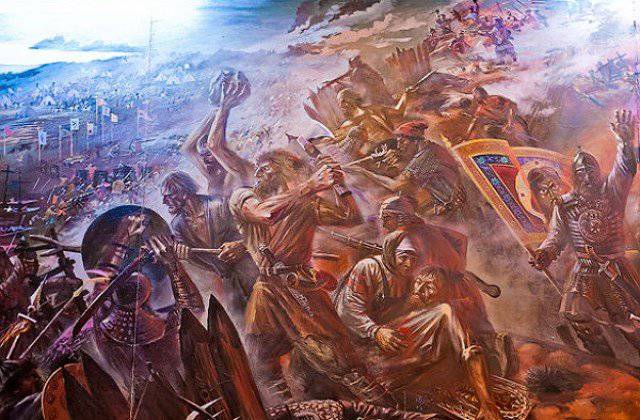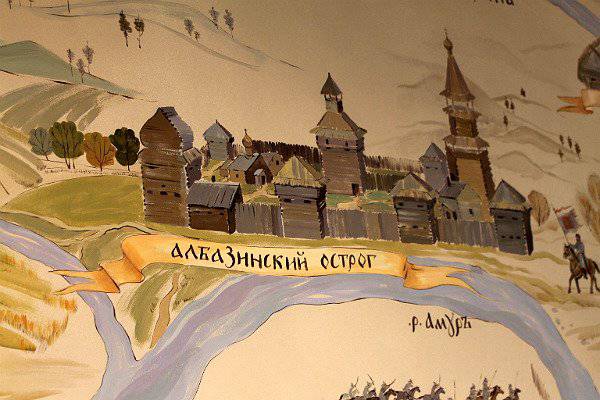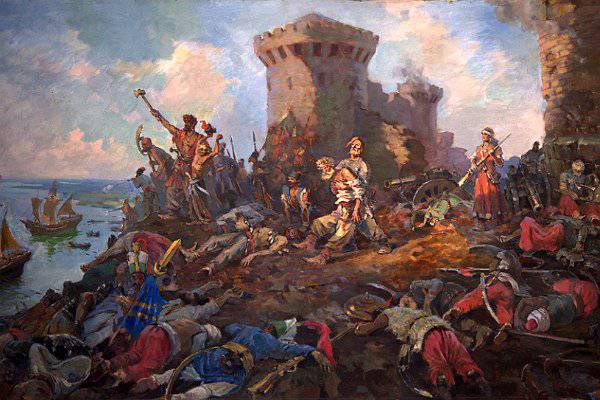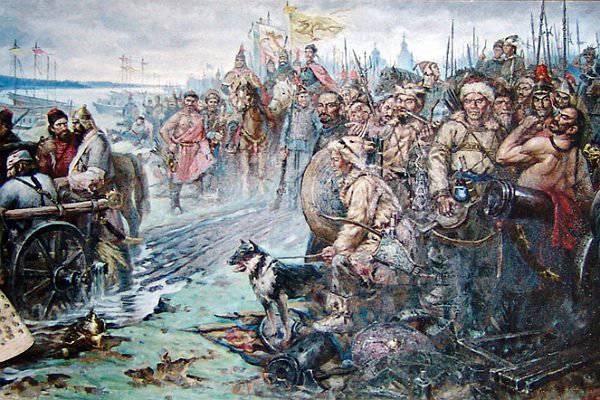Albazinsky siege: Cossacks against the Chinese

How, thanks to the Cossack expansion, the Amur region became Russian
The Great-Russian resettlement to the Far East (as well as the Ukrainian one, by the way) followed exclusively the tracks and notches of the Cossacks. Why it happened this way is easy to understand: there are no vacant territories on Earth, and in order to “master” something, it was necessary to “conquer” something.
In the era of the provincial transformation of Muscovy into the largest European power by the European standards, the Russian autocracy had neither the skills nor the mechanisms for the total mobilization of the Russian population in the central regions of the country to achieve any major foreign policy tasks. Complete absence of Russian ruling environment, until the era of Peter I, habits and mechanisms for a general mobilization of its own people soon convincingly proved many years, losing in the final of the Livonian War and the subsequent hard times of the Time of Troubles. Meanwhile, the territorial expansion of Moscow Russia, beginning from the sixteenth century, was proceeding at a high pace.
Only between the middle of the sixteenth century and the end of the seventeenth century did Moscow Russia, on average, annually (150 years in a row!) Acquire lands equal to the area of modern Holland. By the beginning of the sixteenth century, the Muscovite state was equal in area to the rest of Europe, and Western Siberia, joined by ataman Yermak, was twice the size of Europe. By the mid-seventeenth century Moscovia - without political paroxysms and monstrous war effort of Peter I, in fact without much financial and material investments - became the biggest country in the world.
Who made this colossal length, never, after Genghis Khan and Timur, the territorial increment that was no longer repeated in the world?
Hike Perfilyev and Khabarov
In 1946, in the old Cossack village of Maksimikha Barguzinsky aimak of the Buryat Autonomous Soviet Socialist Republic, Soviet ethnographers wrote down the following words from old-timer Fyodor Gorbunov: “Perfiliev was from the Cossacks and was a Cossack himself. All the early centurions, Pentecostals, commanders and chieftains of their kind came from the Don. Before they came to Siberia, they first walked around the Don, Volga and the Urals. Then, when they heard that they could go to Siberia, they went from the Urals through the Ob to the Yenisei. At the Yenisei they had a main stop, there was the biggest prison. In the prison there lived a voivode - the most important of the Cossacks, whom the tsar himself set for this post. The voivode took all the Cossacks, made troops of them, then sent them to Lena, Angara, the Amur and other rivers. ”
The study of the process of mastering the Slavs of Siberia and the Far East convinces: this supermobilization ethnosocial breakthrough, which the Cossacks made in the east of Eurasia, was only (among the European peoples) under them. Only the Cossacks - the Slavic ethnic group of samurai, people for whom the ideals of human dignity, spiritual freedom, national and social mutual support were not something abstract and distant, and the fact of their everyday reality - could accomplish this feat.
The mentioned Cossack Perfilyev is none other than the famous Cossack ataman Maxim Perfilyev, who was not only a talented commander, but also a skillful diplomat, for he spoke fluently Tatar, Evenki, Mongolian and Chinese. In 1618 — 1627, Perfiliev joined the lands of Upper Tunguska, Lena, and Vitim to Moscow Russia, weapons or diplomacy took the royal tribute from the Aborigines. He built several fortified fortresses - forts, including the famous Bratsk prison (now the city of Bratsk). In the 1638 year, long before Yerofey Khabarov, the ataman Perfilyev went out to Amur - “to gather de Daursky lands.”
Moscow Russia, that is, the Russian state before Peter I, very carefully, deliberately cautiously responded to any initiatives for its territorial expansion. Such initiatives proceeded preferably Cossack. In 1638, the Cossacks took by storm the strategically important Turkish fortress of Azov at the mouth of the Don. In the summer and autumn of 1641, they heroically endured a more than three-month siege that went into military history as the "Azov seat". All this time, until the middle of the year 1642, the Cossacks constantly offered Moscow to take Azov "under his hand", thereby strengthening the Romanov dynasty of vast territories in the Sea of Azov and the mouth of the Don. Moscow has been thinking for a very long time, deliberating for a very long time, but in the end it abandoned Azov. The second time, and at the cost of significant Russian losses, only Peter I managed to take the Azov.
Just as carefully and thoughtfully Moscow and acted in the events of the Pereiaslav Rada, when practically without any military effort - saber Cossacks - Tsar Alexei quietest was presented to Left Bank Ukraine.
In a similar style was implemented the policy of Moscow Russia in Siberia and the Far East. The impression was created that the Trans-Ural lands were for Moskovia a kind of “bagless suitcase.” The absence of a well-thought-out strategic line entailed spontaneity, inconsistency, and even contradictory actions.

For the first time, the absence of a clear solid line of Moscow during the implementation of the policy in the Asian East was clearly manifested in the events connected with the Albazinsky voivodeship.
In 1651, Yerofey Khabarov took the fortified village of the Dahuri prince Albaza, located on the Amur River near the confluence of the Shilka and Argun rivers. Now in this place is located the village of Albazino, Amur region. Khabarov decided to establish a permanent fortress-fortress in this place. Despite the shortage of people in the detachment, he left 50 Cossacks in Albazin and went further down the Amur. Albazin had an exceptionally advantageous strategic location in the upper reaches of the Amur, however, despite this factor, the fortress received no real help from Muscovy, either by people or by gunpowder potions. As a result of the constant attacks of the Manchus in China forced the Cossacks in 1658 year not only leave Albazin, but even to withdraw from all the villages and based krepostits west of the jail.
Reid Nikifor Chernigov
The next parish of Moscow Russia on Amur was again provided with the ethnic energy of the Cossacks. Nikifor of Chernigov, the brightest representative of the Cossack ethnos of the mid-17th century, ensured this return. As part of the troops of the Zaporizhzhya Sich, he fought against Muscovy on the side of the Poles in the Smolensk war (1632 — 1634 years). He was wounded, was captured in Russian, and in 1638, he was exiled to Siberia, to the city of Yeniseisk.
Having shook all the Siberian guards, Nikifor of Chernigov eventually found himself in the farthest corner of the Russian ecumene - in Ilimsk on the Lena. Here the Zaporozhets raised an uprising and personally killed the Ilimsky governor Lavrenty Obukhov, a pathological sadist and bribe-taker. Understanding that now only the executioner's ax can be guaranteed to him from the Moscow tsar, Nikifor of Chernigov, at the head of a detachment from 84 of rebel Cossacks, left for the Amur region, where he re-erected the Albazin fortress. A talented administrator and diplomat, Nicephorus of Chernigov established a Cossack republic in Albazin in the style of the Zaporozhian Sich, founded several new Russian villages around the fortress, and began to regularly collect yasak from the surrounding Aboriginal people.
The Moscow administration looked at the strengthening of the Albazinsky Cossack Republic, successfully controlled by the rebel sentenced to death. Of course, the tsarist governors in Siberia could have organized a punitive campaign against Albazin, but apparently they didn’t really want to fight the Cossacks because of the strengthening of the Chinese empire beyond the Amur.
The affair was decided by a rich tribute, which the visionary Zaporozhets, Nikifor, began to regularly send to Moscow. However, Nikifor of Chernigovsky didn’t have any other way than to try to make peace with Moscow: the stocks of gunpowder seized in Ilimsk were coming to an end, and the onslaught of the Manchus from China became increasingly strong. Apparently, with the mediation of the clergy, the conflict was finally settled: in 1672, the Cossack Nikifor was forgiven and received the title of clerk Albazin, but the Cossack republic, sworn allegiance to the Moscow Tsar, was officially abolished.
The last glorious deed of the Zaporozhye Cossack Nikifor in Albazin was his distant military raid in 1675 on the right bank of Argun and Amur, that is, on the Chinese emperor’s own lands, with the aim of liberating the Slavs and Daurans who were captured by the Manchus. The main problem of Albazin was the catastrophic shortage of people, without whom it was impossible neither to protect the Russian lands on the Amur, nor to ensure their economic development. Cossack Nikifor of Chernigov well understood the complexity of the situation and tried to correct it to the best of his ability.
Moscow Rus’s problems of protecting the region seemed to be worrying much less: the country quickly followed the path of the final general enslavement of the peasants, after which no significant resettlement of the Russian people to Asiatic Ukraine, of course, became impossible. As a result, from 1675 to 1680, only one royal wagon train arrived at Albazin: it carried gunpowder, lead, some seed grain, and only six new male settlers. The impression was created that the tsarist administration was more concerned not with the obvious military preparations of Qing China, but with the personal status of Nikifor of Chernigov, who in Moscow was seen as too significant for a former rebel.
At the end of 1678, under the specious excuse to present Tsar Fyodor Alekseevich Zaporozhets Nikifor from Albazin to Moscow, where after almost two years of ordeal by orders (analogue of today's ministries), this experienced military man and diplomat was identified as a “boyar children” in Krasnoyarsk, that is, an honorary medal fading from melancholy and idleness.
Chinese resistance to Cossack expansion
Immediately after the departure of Nikifor of Chernigov to Moscow, Grigory Lonshakov was appointed clerk in his place. An experienced mining engineer and a good diplomat, Lonshakov, however, did not have any serious military and administrative experience.
If in these years, the growing influence of Muscovite Rus in the region depended only on the personal initiative of a few Cossacks and the arrival of rare carts with military equipment to the region, the strengthening of the Chinese Qing Empire on the right bank of the Amur was planned, strategically meaningful.

In 1679, the Qing emperor Kangxi, a clever politician and skilled administrator, gently removed his relative, Prince Songthot, from power, and took full control of China. Difficult times were approaching for the presence of Muscovy on the Amur - Kansi was a strong-willed, resolute and consistent supporter of the expulsion of the Russian people from the Amur. Strengthening the internal situation of Manchuria and securing military support for the Mongols, in September 1682, the emperor Kangxi organized a reconnaissance raid of the dignitaries (fudutuns) Lantanya and Penchun to Albazin. The extraordinary importance of the upcoming event was emphasized by the fact that the intelligence mission was personally led by Lantany - the future head of the expeditionary army.
The motivation for the unexpected appearance of a high-ranking Chinese governor near the Russian strategic fortress was simple to obscene, because it clearly counted on commoners: Lantan announced to the Russian border guard that he was hunting deer and inadvertently lost. If the Zakorozhye Cossack Nicephorus were a Russian clerk in Albazin, the likelihood that this “hunt” of Lantanya would turn out to be either ineffectual or even the last would be very high. But the Cossack Nikifor at that time was aimlessly wasting time on the honorable resignation in Krasnoyarsk, and the confused servicemen of the Muscovites, instead of immediately dispatching the intruder for Amur, called Lantanya to Albazin, where they were greeted with a true Russian scope.
When Lantan was about to leave, Russian clerks Lonshakov presented the Chinese with a valuable gift. Naive people did not suspect that their main “gift” was already lying in the hiking trail of Lantanya: the Chinese intelligence officer had a full opportunity not only to inspect, but even to sketch, the fortifications of Albazin.
The ethnopolitical naivety of Great Russian clerks turned into a sharp acceleration of China’s military preparations. According to the results of his “hunting” reconnaissance raid, Lantany drew up a detailed plan of the military expedition against Albazin, whose dilapidated wooden fortifications the Chinese assessed as “extremely weak, as if eaten by a hungry donkey.”
The Chinese implemented their plan to oust the Slavs from the Amur systematically and consistently. On the Sungari, the largest tributary of the right bank of the Amur, a river was built flotilla, which was supposed to deliver the expeditionary force and artillery under the walls of Albazin. Here, a three-year supply of food was collected at government warehouses so that the Chinese army would not need anything during the military campaign.
In 1683, the “reindeer hunter” Lantany moved along with the river flotilla to the Amur River and near the mouth of the Zeya was forced to surrender a large Cossack detachment, Gregory the Mylnik, who carried military equipment and supplies for the Dolonsky and Selemdzhinsky barrens. With the loss of this detachment, the Muscovites lost not just an 70 man of an armed reserve, they lost any opportunity for military initiative in the upcoming war. The Albazin fortress lost its defensive side of the field, since Dolonsky and Selemdzhinsky jails had to be left without a fight: without a supply of gunpowder and lead, without the necessary supplies, it was impossible to keep these fortresses.
The only remaining ostrog of the Albazinsky defensive predpole, Verkhnezeysky, was surrounded by a Chinese expeditionary detachment and defended heroically. But what could 20 Cossacks do in a dilapidated fortress against 400 selected Manchurian soldiers? Nevertheless, the Upper Cossacks managed to hold out for almost half a year, and only in February 1684 surrendered.
The hostilities of Emperor Kansi, about which the Yasak Tunguses had warned the Muscovites even in the winter of 1682, naturally took the Tsarist government by surprise. The eternal trend of Russian foreign policy in the East - ignoring the "inconvenient" facts, ingratiating friendly gestures and talking about the world - did not take shape yesterday, already Moscow Russia vividly marked this sad trend.
With the outbreak of hostilities began the assault: what they did not do over the years and decades, tried to do in one or two months. The mining company Lonshakov was immediately dismissed, it was no time for silver. In Albazin they sent a governor of the hereditary Tobolsk Cossack Alexei Tolbuzin, an energetic, intelligent man. Since over the decades that have passed since the raid of Yerofey Khabarov, a meaningful resettlement policy has not yet begun, the “military rank of people” had to be assembled all over Siberia literally by the piece. By the beginning of the storming of Albazin by Chinese troops, these people, of course, did not have time.
Lantan meanwhile did not sleep. In the early summer of 1685, the three-thousandth expeditionary force of China on the military flotilla ships advanced from the Aigun Chinese fortress to Albazin. Eight hundred selected Manchu cavalry walked along the coast. For Great Russians and Cossacks, entrenched in the dilapidated walls, the moment of truth came. The forces of the parties were simply incomparable: at 450 the Cossacks of the Albazin garrison had at least three thousand Chinese infantrymen (5 thousand according to Russian data, which are most likely overstated).
In an incredible rush, clutching at all at once, Tolbuzin’s clerks could not evacuate Russian peasants from the surrounding villages to Albazin in time: the Manchurian cavalry, walking along the coast, captured more 150 fugitives who did not have time to hide in the fortress. When approaching Albazin, the Lantanya flotilla gunned down rafts with Russian fugitives who sailed to Albazin from the upper reaches of the Amur River. According to Chinese data, 40 people were taken from rafts.
In Nerchinsk prison, voivod Ivan Vlasov was hastily gathered about 100 warriors, mostly from peasants, whose military qualities were, to put it mildly, dubious. Somewhere managed to find two guns. However, even this ridiculous, in comparison with the scale of the Chinese invasion, military aid was stuck on the way to Albazin.
Battle of Albazin
12 June 1685, the Chinese Expeditionary Force landed at Albazin. A methodical bombardment of the fortress from the so-called "dray" guns began. The Albazin fortress walls fully justified the derogatory assessment of Lantanya in the part of “hunger-hungry donkey”: the Chinese cores sometimes pierced the fortress through, punching at the same time both walls opposite to each other. The bombardment lasted for three days and was very productive: more than 100 people were killed, barns with food were completely burned, one of the three fortress guns was broken.
Early in the morning of June 16, in a predawn fog, the drums of the battle suddenly barked and a rhythmic, plaintive voice of dulcimers rang out: it was the Chinese who went to the attack simultaneously from all sides. Fiercely waving huge glittering sabers, the vanguard of the Chinese infantry, made up of two-meter-tall skinheads, with a wild war cry rushed to the walls of the fortress. Placed in a special order, the Chinese fusiliers, with coordinated volleys of their fuzes, supported the “firing shaft” before the guardsmen.

It seemed that nothing could save the defenders of Albazin from universal extermination. Nothing but Cossack courage and marshy swampy moat in front of the walls of the fortress. It was just the case when the laxity of the Moscow boyars played a good service. The defensive ditch of Albazin was not cleaned for years, it was completely silted up and, at first glance, it seemed to be dried out, which is why the Chinese did not prepare siege bridges in advance.
In the fury of the assault, skinheads threw themselves across the ditch and immediately tied up to the waist. This was used by the Cossacks, who fired at an emphasis on the crowded mass of human bodies. A small detachment of Donts and Zaporozhians from 26, under the leadership of the centurion Stephen Boyko, rushed with daggers through the wall in an attempt to seize the main standard of the advancing guardsmen. Cossacks killed almost everyone (only four people survived), the standard was not captured, but they laid a whole street of skinheads to the standard.
As a result of all these circumstances, the Chinese plan of a single-stage assault was foiled, the struggle for the walls disintegrated into several foci. This circumstance was brilliantly used by voivode Tolbuzin, skillfully transferring Cossacks and “every rank of Russian people” from one place of a breakthrough to another.
We must pay tribute to the Chinese: they persistently, even fanatically, regardless of the losses, stormed Albazin all day. Only at 10 hours of the evening did the Kangxi soldiers retreat to their camp. Their losses were monstrous: Lantan lost more than 400 soldiers killed and wounded.
The next day, stubborn Lantan gave the order to prepare a new assault. The Chinese began to cut down the surrounding forest and fill up the moat with tree trunks. They worked freely, since the defenders of Albazin had practically no gunpowder.
Under these conditions, the voivode Tolbuzin proved himself to be a skillful and strong-willed diplomat: he managed to agree with Lantan on the withdrawal of the garrison of the fortress and all Russian people towards Nerchinsk, that is, where the Cossack militia was actively assembled and was already partly ready. The Chinese insisted on the departure of the Albazin Cossacks to the north, towards Yakutsk, which guaranteedly led to additional human losses and deprived the Cossacks of any chance to continue the resistance. At the key moment of the negotiations, Tolbuzin “turned the chessboard”: he told Lantanya that either the open road to Nerchinsk — or the Cossacks would continue to resist. Lantan agreed.
26 June 1685, the Cossacks and the Russian peasants left the fortress and marched westward in a battle march. To the military honor of the officers of Kansi, the Chinese kept their word - the way to Nerchinsk was open, the Chinese did not attack and did not even form battle formations. After the departure of Tolbuzin, Lantany blew up partly, and partly tore up the fortifications of Albazin. Then he went to the rear Aygunskoy fortress.
At the beginning of July in Nerchinsk, all the forces of the Trans-Baikal Cossacks and the Russian militia, a total of about 1200, finally joined. Feeling at hand a real military force, the courageous Tolbuzin gathered the Military Circle, where the Cossacks unanimously refused to "bring glory from Albazin."
Here, in Nerchinsk, Tolbuzin found himself a reliable comrade. They became a German, baptized into Orthodoxy, Athanasius Beyton, a man of exceptional courage and great will. Beyton brought Don Cossacks and Russian peasants from Western Siberia to Nerchinsk, and up to the death of Tolbuzin remained his most reliable support.
27 August 1685 of the year Cossack planes again approached the blown-up walls of Albazin. This time, the military forces of the governor Tolbuzin were more or less tangible: 714 Cossacks (of which 200 are cavalry) and 155 are Russian fishermen and peasants who wished to return to Amur. They managed to restore the fortress with genuine labor before the first snow. Ahead of them was a terrible war of attrition with the best troops of the Qing Empire, and there was nothing behind their shoulders except immense, deserted Siberia and distant Moscow, in which and around which many hundreds of faithful Russians who were accused of ecclesiastical "Split".
Information